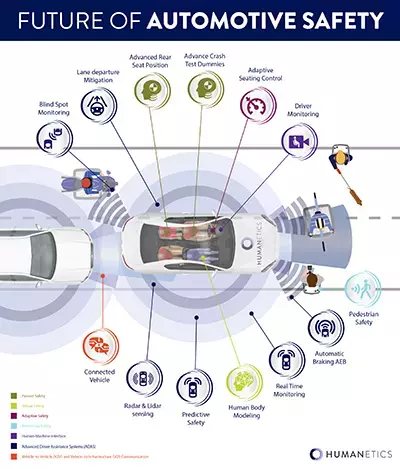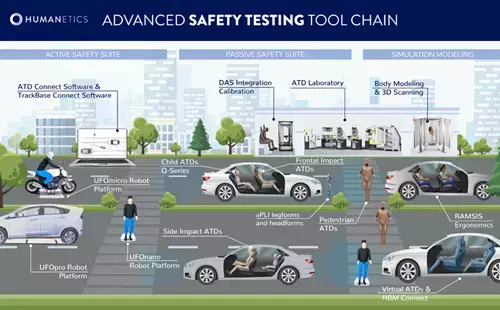
From Automated Systems to Virtual Technology, Innovations in Vehicle Safety Hold Promise for Saving Lives
 Imagine, if you will, you are driving peacefully along a gently winding mountain road after the last bit of sunlight drops gracefully from sight behind a silhouetted landscape. But soon, with little warning, the tranquil evening’s weather suddenly turns treacherous, with thick fog enveloping your surroundings. Visibility drops to near-zero and anxiety creeps in as you suddenly find yourself struggling to safely navigate the obscured road ahead. Abruptly, a deer darts across the lane in front of you, barely catching your eye in the headlights. Startled, you instinctively hit the brakes, but the car's ADAS system has already kicked into action with lightning speed. Utilizing its enhanced sensors and real-time object detection capabilities, it had identified the deer's presence and immediately applied the brakes with optimal force to avoid a collision. Safely composed, you breathe a sigh of relief, ever thankful for the advanced technology that saved you from what could have been a serious crash. Your newfound gratitude serves as a powerful reminder of how ADAS can be a true lifesaver, empowering drivers to navigate unexpected hazards and ensuring a safer driving experience.
Imagine, if you will, you are driving peacefully along a gently winding mountain road after the last bit of sunlight drops gracefully from sight behind a silhouetted landscape. But soon, with little warning, the tranquil evening’s weather suddenly turns treacherous, with thick fog enveloping your surroundings. Visibility drops to near-zero and anxiety creeps in as you suddenly find yourself struggling to safely navigate the obscured road ahead. Abruptly, a deer darts across the lane in front of you, barely catching your eye in the headlights. Startled, you instinctively hit the brakes, but the car's ADAS system has already kicked into action with lightning speed. Utilizing its enhanced sensors and real-time object detection capabilities, it had identified the deer's presence and immediately applied the brakes with optimal force to avoid a collision. Safely composed, you breathe a sigh of relief, ever thankful for the advanced technology that saved you from what could have been a serious crash. Your newfound gratitude serves as a powerful reminder of how ADAS can be a true lifesaver, empowering drivers to navigate unexpected hazards and ensuring a safer driving experience.
In an era where technology is rapidly transforming various aspects of our lives, the automotive industry is no exception. Today, more than ever, manufacturers, engineers, and researchers are working tirelessly to develop groundbreaking innovations that have the potential to revolutionize how we protect ourselves on the road.
Today’s roadmap for improving road user safety is hedged on the integration of advanced technologies such as autonomous driving, connected vehicles, and advanced driver assistance systems (ADAS). These technologies are designed to reduce the likelihood of crashes caused by human error. Extensive adoption of adaptive systems such as smart seat belts and airbags, improved driver assistance systems, virtual human and dummy models, and physical passive safety tools all culminate to provide better protection for everyone in the event of a crash.
So, let’s take a quick look at some of the main drivers of this safer future, including Adaptive Safety, Active Safety, Virtual Environments, Test Dummies, and Vulnerable Road User safety to paint a picture of safer possibilities now and in the future.
Today, more than ever, manufacturers, engineers, and researchers are working tirelessly to develop groundbreaking innovations that have the potential to revolutionize how we protect ourselves on the road.
Preventing Crashes with Active Safety
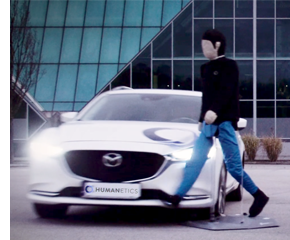 Automotive active safety refers to the technologies and systems that are designed to prevent collisions before they occur. ADAS technologies such as lane departure warning, automatic emergency braking, and adaptive cruise control will become more widespread and sophisticated and will improve a vehicle's ability to detect and respond to potential hazards on the road.
Automotive active safety refers to the technologies and systems that are designed to prevent collisions before they occur. ADAS technologies such as lane departure warning, automatic emergency braking, and adaptive cruise control will become more widespread and sophisticated and will improve a vehicle's ability to detect and respond to potential hazards on the road.
Looking even further ahead, the evolution of autonomous vehicles will play a pivotal role in advancing safety. As self-driving technology continues to mature, the potential for human error will be dramatically reduced, leading to a significant decrease in collisions caused by speeding, distracted, and impaired driving. Moreover, communication between autonomous vehicles will enable a coordinated response to potential risks, further enhancing safety for all road users.
Interestingly, AI-powered technologies have the potential to transform the way vehicles respond to potential hazards. Machine learning algorithms, combined with an array of sensors and cameras, may enable cars to interpret their surroundings and make split-second decisions to avoid impacts. These systems can detect pedestrians, cyclists, and other vehicles, issuing warnings or even autonomously applying brakes when necessary. This same technology could fuel predictive safety using machine learning algorithms that allow vehicles to analyze data from a variety of sources, and other connected vehicles, to predict potential safety risks and respond proactively. As AI continues to advance, it is expected that these systems will become more refined and capable of preventing a wider range of crashes.
Customizing Preparation with Adaptive Safety
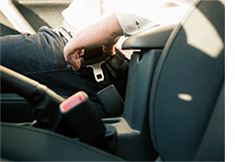 Although not yet in the mainstream safety toolbox, automotive adaptive safety is an evolving concept using advanced technologies to dynamically adjust the safety systems in a vehicle in response to changing driving conditions. These occupant protection systems are being designed with a greater focus on customization and individual needs. Adaptive airbags, for instance, are being developed to inflate differently depending on factors such as the size, weight, and position of the occupant. This tailored approach may reduce the risk of injury and enhance protection for passengers of all ages and sizes. Moreover, smart seat belts are also being investigated to not only restrain occupants during an impact but also provide real-time feedback on proper usage, preventing potential injuries caused by incorrect belt positioning.
Although not yet in the mainstream safety toolbox, automotive adaptive safety is an evolving concept using advanced technologies to dynamically adjust the safety systems in a vehicle in response to changing driving conditions. These occupant protection systems are being designed with a greater focus on customization and individual needs. Adaptive airbags, for instance, are being developed to inflate differently depending on factors such as the size, weight, and position of the occupant. This tailored approach may reduce the risk of injury and enhance protection for passengers of all ages and sizes. Moreover, smart seat belts are also being investigated to not only restrain occupants during an impact but also provide real-time feedback on proper usage, preventing potential injuries caused by incorrect belt positioning.
As self-driving technology continues to mature, the potential for human error will be dramatically reduced, leading to a significant decrease in collisions caused by speeding, distracted, and impaired driving.
Protection When Crashes Happen: Passive Safety
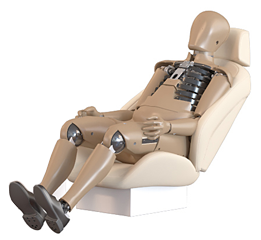 Since the definition of passive safety constitutes the mitigation of injury once the crash event is already in motion, this archetype is dependent upon the effectiveness of reliable testing in both the physical and digital paradigms. Since the concept of autonomous vehicles with active safety systems increasingly remove human driver activity, the position of occupants within the cabin could vary and present challenges for safety when an impact does occur. Relaxing in new seating positions and new seating directions will require new ways to keep occupants safe from impact, and safe from each other during an impact.
Since the definition of passive safety constitutes the mitigation of injury once the crash event is already in motion, this archetype is dependent upon the effectiveness of reliable testing in both the physical and digital paradigms. Since the concept of autonomous vehicles with active safety systems increasingly remove human driver activity, the position of occupants within the cabin could vary and present challenges for safety when an impact does occur. Relaxing in new seating positions and new seating directions will require new ways to keep occupants safe from impact, and safe from each other during an impact.
Autonomous Vehicle crash test dummies provide a new means to test the effectiveness of occupant safety in these vehicles of the future. Their ability to measure forces on the body within these altered environments using reclined seating postures, new neck dynamics, and more flexible pelvic structures make them a valuable new tool in AV testing regimens.
Expanding Safer Design: The Digital Virtual World
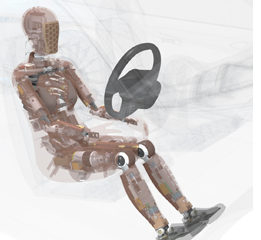 Virtual human body models and virtual crash test dummies are computer-generated representations of the human body and its response to various types of impacts during a crash. They can help improve occupant safety by providing faster and more cost-effective safety analysis. Engineers can simulate and analyze a wide range of crash scenarios in a virtual environment, reducing the time and cost associated with physical crash testing. Virtual models can also provide a more accurate representation of human anatomy and biomechanics, allowing for a more detailed analysis of injury risk and enhancing our understanding of injury mechanisms in different crash scenarios.
Virtual human body models and virtual crash test dummies are computer-generated representations of the human body and its response to various types of impacts during a crash. They can help improve occupant safety by providing faster and more cost-effective safety analysis. Engineers can simulate and analyze a wide range of crash scenarios in a virtual environment, reducing the time and cost associated with physical crash testing. Virtual models can also provide a more accurate representation of human anatomy and biomechanics, allowing for a more detailed analysis of injury risk and enhancing our understanding of injury mechanisms in different crash scenarios.
The personalization of safety is now well within the grasp of the digital landscape. Virtual human body models and virtual crash test dummies can be customized to represent a wide range of demographic characteristics, such as age, height, weight, and posture, allowing engineers to analyze the impact of these factors on injury risk and outcomes.
Virtual models already play a critical role in improving occupant safety by allowing engineers to test more extensively than physical programs will allow, thereby contributing to the design of safer vehicles and safety systems that are better suited to the needs of real-world drivers and passengers.
Analyzing More Body Types: Vulnerable Road Users
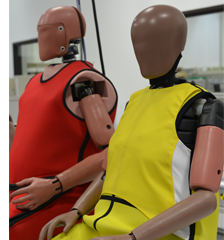 Vulnerable road users, such as cyclists and pedestrians, are at a higher risk of injury or death in the event of a crash, accounting for over half of fatalities worldwide. [1] The integration of ADAS technologies, such as automatic emergency braking, lane departure warning, and pedestrian detection, as with occupants, can also help reduce the likelihood of crashes involving road users outside of automobiles by alerting drivers to potential hazards and, in some cases, taking corrective action automatically.
Vulnerable road users, such as cyclists and pedestrians, are at a higher risk of injury or death in the event of a crash, accounting for over half of fatalities worldwide. [1] The integration of ADAS technologies, such as automatic emergency braking, lane departure warning, and pedestrian detection, as with occupants, can also help reduce the likelihood of crashes involving road users outside of automobiles by alerting drivers to potential hazards and, in some cases, taking corrective action automatically.
But vulnerable road users could also be inside the vehicle as well. Human bodies can differ in their kinematic properties during a crash by size, age, and gender. Larger occupants, seniors, and females can all fall into the category of vulnerable users, since crash testing and analysis has been traditionally performed using mid-sized male centric ATDs, thereby optimizing safety design for this normalized body type. [2] Expanding passive safety testing using more equitable crash test dummies is sure to make a difference in how we analyze and design safety into our vehicles.
Onward
As we navigate the ever-changing landscape of the automotive industry, one thing remains clear: vehicle occupant safety is evolving at an unprecedented pace. The integration of active safety systems, AI, customization, new communication systems, and high-level autonomous technology heralds a future where crashes can be minimized, lives can be saved, and the roads can become safer for everyone.
It is also worth noting that The Safe System Approach for transportation safety, a methodology promoted by experts worldwide, focuses on five key elements: safe road users, safe vehicles, safe speeds, safe roads and roadsides, and post-crash care. With this kind of holistic approach, we can inch closer to a future where serious injury is nothing more than a distant memory and transportation becomes an inherently safer experience for everyone.

Mark Brown
Mark is the Product Marketing Manager at Humanetics Safety and works closely with Engineering and Sales to develop and refine content that is both useful and informative for our industry. With over two decades of experience in crash test dummy product Quality, Technical, Sales, and Marketing, Mark produces a wide range of media and publications including our service bulletins, webinars, editorial articles, and contributes to our marketing collateral.
